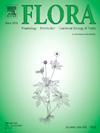一种因紫外线缓冲而在气候变化下高度稳定生存的药用植物——菊花未来适应性分析
IF 1.8
4区 生物学
Q3 ECOLOGY
引用次数: 0
摘要
明确物种的适当分布范围是应对气候变化影响的一项基本任务。草药是中国传统中药体系的重要组成部分,其中菊花(Chrysanthemum indicum L., C. indicum)是一种重要的药用植物,在气候变化和经济影响的推动下,其需求日益增长。因此,正确评估籼稻对持续变化的气候的响应,探索其生存稳定性至关重要。利用MaxEnt模型,基于气候、土壤、地形等环境因子,模拟了低强迫情景(ssp1 ~ 2.6)和高强迫情景(ssp5 ~ 8.5)下中国籼稻适宜生境的变化,并量化了适宜区潜在变化。结果表明:在当前气候条件下,籼稻的适宜生长区域主要集中在长江流域和长江以南地区,湖北省是籼稻最适宜的生境,预计未来较长时期内这种分布将基本保持稳定。季节性紫外线b辐射(UVB2)被认为是最重要的环境因子。此外,还提出了“UV-B缓冲假说”,认为当UV-B辐射是一个关键的限制因子时,即使气候变暖,物种分布也能保持稳定。综上所述,这些发现为籼稻的生产和未来保护规划提供了见解,并为在不断变化的世界中保护其他依赖uv - b的物种提供了路线图。本文章由计算机程序翻译,如有差异,请以英文原文为准。
A medicinal plant highly stable for survival under climate change due to UV buffering–Chrysanthemum indicum L. future adaptation analysis
Clarifying the appropriate distribution range of species is a fundamental task in addressing the effects of climate change. Herbal medicine is an important part of China's traditional Chinese medicine (TCM) system, and among them, Chrysanthemum indicum L. (C. indicum) is a vital medicinal plant facing growing demand driven by climate change and economic influences. Consequently, it is crucial to properly assess how C. indicum responds to the continuously changing climate and explore its survival stability. In this study, the MaxEnt model was employed to simulate the shifts in suitable habitats for the species of C. indicum in China from the present to the 2100s under two scenarios, a low forcing scenario (SSP1–2.6) as well as a high forcing scenario (SSP5–8.5), on the basis of environmental factors including climate, soil, and topography, and quantified the potential changes in the suitable areas. The results demonstrated that under current climate conditions, the suitable areas for C. indicum are concentrated in the Yangtze River Basin and areas south of the Yangtze River in China, the most suitable habitat was identified in Hubei Province, and this distribution is projected to remain largely stable over an extended period in the future. Seasonal ultraviolet-B radiation (UVB2) was identified as the most influential environmental factor. In addition, the “UV-B buffer hypothesis” was proposed, suggesting that when UV-B radiation serves as a key limiting factor, species distribution can remain stable despite climate warming. Taken together, the findings offer insights into the production and future conservation planning of C. indicum, and provide a roadmap for the preservation of other UV-B-dependent species in a changing world.
求助全文
通过发布文献求助,成功后即可免费获取论文全文。
去求助
来源期刊

Flora
生物-植物科学
CiteScore
3.30
自引率
10.50%
发文量
130
审稿时长
54 days
期刊介绍:
FLORA publishes original contributions and review articles on plant structure (morphology and anatomy), plant distribution (incl. phylogeography) and plant functional ecology (ecophysiology, population ecology and population genetics, organismic interactions, community ecology, ecosystem ecology). Manuscripts (both original and review articles) on a single topic can be compiled in Special Issues, for which suggestions are welcome.
FLORA, the scientific botanical journal with the longest uninterrupted publication sequence (since 1818), considers manuscripts in the above areas which appeal a broad scientific and international readership. Manuscripts focused on floristics and vegetation science will only be considered if they exceed the pure descriptive approach and have relevance for interpreting plant morphology, distribution or ecology. Manuscripts whose content is restricted to purely systematic and nomenclature matters, to geobotanical aspects of only local interest, to pure applications in agri-, horti- or silviculture and pharmacology, and experimental studies dealing exclusively with investigations at the cellular and subcellular level will not be accepted. Manuscripts dealing with comparative and evolutionary aspects of morphology, anatomy and development are welcome.
 求助内容:
求助内容: 应助结果提醒方式:
应助结果提醒方式:


